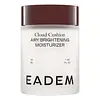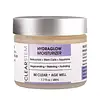What's inside
What's inside
 Key Ingredients
Key Ingredients

 Benefits
Benefits

 Concerns
Concerns

No concerns
 Ingredients Side-by-side
Ingredients Side-by-side

Water
Skin ConditioningGlycerin
HumectantCaprylic/Capric Triglyceride
MaskingGlyceryl Stearate Se
EmulsifyingAstrocaryum Vulgare Kernel Oil
Skin ConditioningCetearyl Alcohol
EmollientNiacinamide
SmoothingOrbignya Oleifera Seed Oil
EmollientSqualane
EmollientMethylpropanediol
SolventShorea Stenoptera Seed Butter
EmollientNigella Sativa Seed Oil
EmollientSodium Polyacrylate
AbsorbentDimethicone
EmollientAvena Sativa Bran Extract
AbrasiveCetyl Alcohol
EmollientPhenoxyethanol
PreservativeCeteareth-20
CleansingCaprylyl Glycol
EmollientSodium Lauroyl Lactylate
EmulsifyingOryza Sativa Bran Extract
Skin ConditioningBisabolol
MaskingCitrus Aurantium Dulcis Peel Extract
Emulsion StabilisingBetaine
HumectantAdenosine
Skin ConditioningSodium Phytate
Ceramide NP
Skin ConditioningHelianthus Annuus Extract
EmollientCeramide AP
Skin ConditioningPhytosphingosine
Skin ConditioningTremella Fuciformis Sporocarp Extract
AntioxidantCholesterol
EmollientTocopherol
AntioxidantRosmarinus Officinalis Leaf Extract
AntimicrobialXanthan Gum
EmulsifyingCarbomer
Emulsion StabilisingEthylhexylglycerin
Skin ConditioningTetrapeptide-30
Skin ConditioningPotassium Sorbate
PreservativeZingiber Officinale Root Extract
MaskingCeramide EOP
Skin ConditioningWater, Glycerin, Caprylic/Capric Triglyceride, Glyceryl Stearate Se, Astrocaryum Vulgare Kernel Oil, Cetearyl Alcohol, Niacinamide, Orbignya Oleifera Seed Oil, Squalane, Methylpropanediol, Shorea Stenoptera Seed Butter, Nigella Sativa Seed Oil, Sodium Polyacrylate, Dimethicone, Avena Sativa Bran Extract, Cetyl Alcohol, Phenoxyethanol, Ceteareth-20, Caprylyl Glycol, Sodium Lauroyl Lactylate, Oryza Sativa Bran Extract, Bisabolol, Citrus Aurantium Dulcis Peel Extract, Betaine, Adenosine, Sodium Phytate, Ceramide NP, Helianthus Annuus Extract, Ceramide AP, Phytosphingosine, Tremella Fuciformis Sporocarp Extract, Cholesterol, Tocopherol, Rosmarinus Officinalis Leaf Extract, Xanthan Gum, Carbomer, Ethylhexylglycerin, Tetrapeptide-30, Potassium Sorbate, Zingiber Officinale Root Extract, Ceramide EOP
Water
Skin ConditioningSqualane
EmollientPropanediol
SolventCannabis Sativa Seed Oil
EmollientPunica Granatum Seed Oil
EmollientPolyglyceryl-6 Distearate
EmulsifyingGlycerin
HumectantCetyl Alcohol
EmollientRaphanus Sativus Seed Extract
Skin ConditioningBakuchiol
AntimicrobialAloe Barbadensis Leaf Extract
EmollientHyaluronic Acid
HumectantJojoba Esters
EmollientOlibanum
MaskingCamellia Sinensis Extract
AntioxidantSodium Cocoyl/Stearoyl (Alanine/Arginine/Asparagine/Aspartic Acid/Glutamic Acid/Glutamine/Glycine/Histidine/Isoleucine/Leucine/Lysine/Phenylalanine/Proline/Serine/Threonine/Tyrosine/Valine)
EmollientPhenylalanine
MaskingArgania Spinosa Sprout Cell Extract
Skin ConditioningCurcuma Longa Root Extract
MaskingTanacetum Annuum Flower Oil
MaskingLactobacillus Ferment
Skin ConditioningDiglucosyl Gallic Acid
Thioctic Acid
AntioxidantLactic Acid
BufferingXanthan Gum
EmulsifyingCaprylyl Glycol
EmollientEthylhexylglycerin
Skin ConditioningWater, Squalane, Propanediol, Cannabis Sativa Seed Oil, Punica Granatum Seed Oil, Polyglyceryl-6 Distearate, Glycerin, Cetyl Alcohol, Raphanus Sativus Seed Extract, Bakuchiol, Aloe Barbadensis Leaf Extract, Hyaluronic Acid, Jojoba Esters, Olibanum, Camellia Sinensis Extract, Sodium Cocoyl/Stearoyl (Alanine/Arginine/Asparagine/Aspartic Acid/Glutamic Acid/Glutamine/Glycine/Histidine/Isoleucine/Leucine/Lysine/Phenylalanine/Proline/Serine/Threonine/Tyrosine/Valine), Phenylalanine, Argania Spinosa Sprout Cell Extract, Curcuma Longa Root Extract, Tanacetum Annuum Flower Oil, Lactobacillus Ferment, Diglucosyl Gallic Acid, Thioctic Acid, Lactic Acid, Xanthan Gum, Caprylyl Glycol, Ethylhexylglycerin
 Reviews
Reviews

Ingredients Explained
These ingredients are found in both products.
Ingredients higher up in an ingredient list are typically present in a larger amount.
Caprylyl Glycol is a humectant and emollient, meaning it attracts and preserves moisture.
It is a common ingredient in many products, especially those designed to hydrate skin. The primary benefits are retaining moisture, skin softening, and promoting a healthy skin barrier.
Though Caprylyl Glycol is an alcohol derived from fatty acids, it is not the kind that can dry out skin.
This ingredient is also used as a preservative to extend the life of products. It has slight antimicrobial properties.
Learn more about Caprylyl GlycolCetyl Alcohol is a fatty alcohol. Fatty Alcohols are most often used as an emollient or to thicken a product.
Its main roles are:
Though it has "alcohol" in the name, it is not related to denatured alcohol or ethyl alcohol.
The FDA allows products labeled "alcohol-free" to have fatty alcohols.
Learn more about Cetyl AlcoholEthylhexylglycerin (we can't pronounce this either) is commonly used as a preservative and skin softener. It is derived from glyceryl.
You might see Ethylhexylglycerin often paired with other preservatives such as phenoxyethanol. Ethylhexylglycerin has been found to increase the effectiveness of these other preservatives.
Glycerin is already naturally found in your skin. It helps moisturize and protect your skin.
A study from 2016 found glycerin to be more effective as a humectant than AHAs and hyaluronic acid.
As a humectant, it helps the skin stay hydrated by pulling moisture to your skin. The low molecular weight of glycerin allows it to pull moisture into the deeper layers of your skin.
Hydrated skin improves your skin barrier; Your skin barrier helps protect against irritants and bacteria.
Glycerin has also been found to have antimicrobial and antiviral properties. Due to these properties, glycerin is often used in wound and burn treatments.
In cosmetics, glycerin is usually derived from plants such as soybean or palm. However, it can also be sourced from animals, such as tallow or animal fat.
This ingredient is organic, colorless, odorless, and non-toxic.
Glycerin is the name for this ingredient in American English. British English uses Glycerol/Glycerine.
Learn more about GlycerinSqualane is an emollient that helps the skin hold onto moisture. It's an oily liquid that occurs naturally in certain types of fish and plant oils.
Because squalane boosts hydration in the skin, it also comes with plenty of benefits: it is an antioxidant and can help fight free radicals and skin damage. Squalane is also found to have a detoxifying effect when applied.
Squalane comes from squalene, which occurs naturally within the sebum of our skin. It is one of the oils our skin produces to keep itself hydrated. Squalane is the hydrogenated version of squalene and has a longer shelf life.
Research shows that squalane is non-irritating (even at 100% concentration).
In general, it's a fantastic ingredient. It does a great job at hydrating the skin, and it's suitable for those with sensitive skin.
The source of squalane may impact malassezia / fungal acne. This is because olive oil derived squalane can contain impurities such as fatty acids and plant waxes. Sugarcane derived squalane is recommended for anyone with malassezia concerns.
Is squalane vegan?
This depends on the source. Squalane can be derived from both plants and animals. Most squalane used in skincare comes from plants.
Please note: the source of squalane is only known if disclosed by the brand. We recommend reaching out to the brand if you have any questions about their squalane.
Read more about squalene with an "e".
Is squalane an oil?
Squalane is often called an oil, but it’s technically not; it’s a hydrocarbon, meaning it’s only made of carbon and hydrogen, unlike true oils which are triglycerides made of fatty acids and glycerol.
The term “oil-free” isn’t regulated, so companies can define it however they want. Some exclude all oils, while others just avoid mineral oil or comedogenic oils.
While some people avoid oils thinking they cause breakouts, the right kind of oil (or oil-like ingredient like squalane) can actually help balance and hydrate your skin. It’s worth testing out simple oils or squalane to see what works best for your skin.
Learn more about SqualaneWater. It's the most common cosmetic ingredient of all. You'll usually see it at the top of ingredient lists, meaning that it makes up the largest part of the product.
So why is it so popular? Water most often acts as a solvent - this means that it helps dissolve other ingredients into the formulation.
You'll also recognize water as that liquid we all need to stay alive. If you see this, drink a glass of water. Stay hydrated!
Learn more about WaterXanthan gum is used as a stabilizer and thickener within cosmetic products. It helps give products a sticky, thick feeling - preventing them from being too runny.
On the technical side of things, xanthan gum is a polysaccharide - a combination consisting of multiple sugar molecules bonded together.
Xanthan gum is a pretty common and great ingredient. It is a natural, non-toxic, non-irritating ingredient that is also commonly used in food products.
Learn more about Xanthan Gum